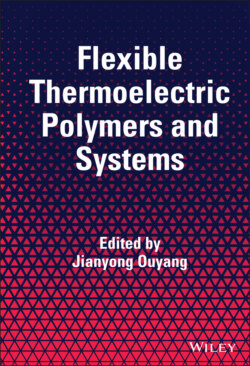Читать книгу Flexible Thermoelectric Polymers and Systems - Группа авторов - Страница 10
Оглавление
Preface
Thermoelectric materials are interesting because they can be used to directly convert heat into electricity. Some conductive materials can exhibit a notable voltage under temperature gradient, that is, the Seebeck effect. The thermovoltage with respect to the temperature is called Seebeck voltage. The Seebeck voltage can be positive or negative depending on the accumulation of the charge carrier(s) at the two ends under temperature gradient. A p‐type thermoelectric material exhibits a positive Seebeck voltage, while an n‐type thermoelectric material has a negative Seebeck voltage. High Seebeck coefficient has been observed on semiconductors and semimetals. The value is related to the relative position of the Fermi level from the top of the valence band or the bottom of the conduction band or simply the doping level since a change in the doping level can shift the Fermi level. Apart from the Seebeck coefficient, a high electrical conductivity is also required for efficient thermoelectric conversion. However, a good thermoelectric material should have a low thermal conductivity so that more heat can be utilized for power generation. Thermoelectric materials are used as the active materials of thermoelectric generators. They can be used in thermoelectric cooling systems in terms of the Peltier effect as well.
The conventional thermoelectric materials are inorganic semiconductors or semimetals such as Bi2Te3 and its derivatives or analogues. These materials can exhibit high Seebeck coefficient and high electrical conductivity, but they also have a problem of high thermal conductivity. Hence, great effort has been made on lowering the thermal conductivity of inorganic thermoelectric materials besides on the improvement in the Seebeck coefficient and/or electrical conductivity. Consider for practical application, inorganic thermoelectric materials are usually brittle, and thus they are not suitable for flexible thermoelectric systems.
Polymers emerge as the next‐generation thermoelectric materials mainly due to their high mechanical flexibility. Flexible thermoelectric materials can enable the realization of flexible or even portable/wearable thermoelectric generators or coolers. They are significant because of the ubiquitous heat on earth and the convenient heat collection related to the mechanical flexibility. For example, a wearable thermoelectric generator can harvest heat from human body and provide electricity to other wearable or implanted devices that are used for communication or healthcare. Polymers have much lower thermal conductivity than their inorganic counterparts, but their Seebeck coefficient is remarkably inferior to the latter. Therefore, the research focus on developing high‐performance thermoelectric polymers is very different from developing high‐performance inorganic thermoelectric materials.
Thermoelectric polymers are intrinsically conducting polymers in the doped state. They have conjugated backbone, and their charge carriers are produced through the chemical oxidation or reduction. Although intrinsically conducting polymers have been studied for more than 40 years since the discovery of conducting polyacetylene in 1970s, their thermoelectric properties only recently gained considerable attention. Hence, some researchers in the area of organic/polymer electronics may not be very familiar with the knowledge of thermoelectrics. The first chapter of this book introduces the fundamental knowledge of thermoelectric materials, thermoelectric effects, thermoelectric generators, and Peltier coolers. Some fundament knowledge of thermoelectric polymers is notably different from that of inorganic thermoelectric materials. Chapter 2 provides an overall review on the thermoelectric polymers. The thermoelectric properties of polymers depend not only on their chemical structure but also on their doping level and morphology. The most popular thermoelectric polymers are the poly(3,4‐ethylenedioxythiophene) (PEDOT) family, and they are reviewed in Chapter 3. Although intrinsically conducting polymers can be prepared through chemical synthesis, electrochemical polymerization is also popular for the preparation of intrinsically conducting polymers. The Chapter 4 reviews the thermoelectric polymers by electrochemical synthesis. Apart from electronic conductors including semiconductors, semimetals and intrinsically conducting polymers, ionic conductors recently attracted great attention owing to their high thermovoltage that is usually higher than that of electronic conductors by two to three orders by magnitude. In addition, they can affect the thermoelectric properties of polymers as well. This is covered in Chapter 5. Chapter 6 provides a comprehensive review on the thermoelectric polymer composites. The nanofillers in the composites can greatly improve the thermoelectric properties of polymers. The last chapter introduces the thermoelectric properties of low‐dimensional thermoelectric materials including zero‐dimensional nanoparticles, one‐dimensional nanowire or nanotubes, and two‐dimensional materials. These low‐dimensional materials can exhibit interesting thermoelectric materials, and they are often used as the nanofillers in thermoelectric polymer composites for practical application.
I am grateful to all the authors for their contributions to this book particularly in this special time of the COVID‐19 pandemic. I also would like to thank my wife and my two sons for their support.
Jianyong Ouyang
